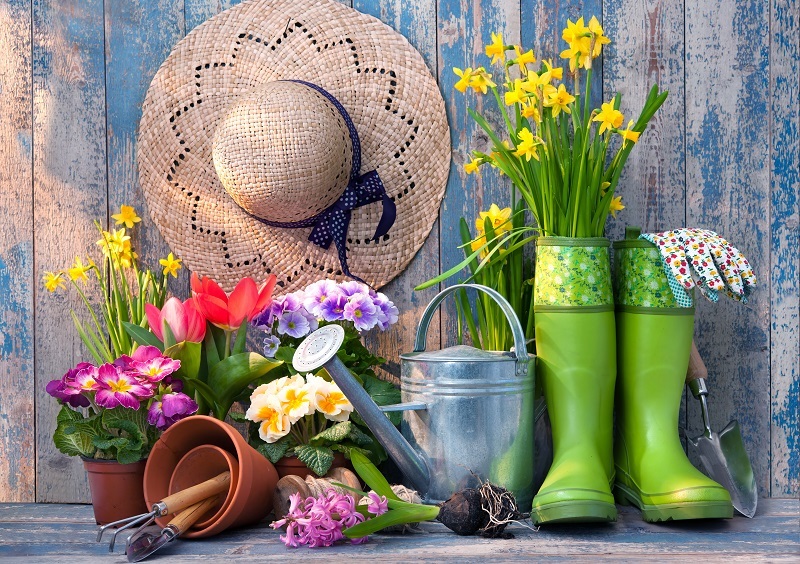Master simple ways to extend the life of your flowers
Posted on 04/07/2025
There's something special about a vase of fresh flowers brightening up a room. Whether it's a gift from a loved one, a celebration bouquet, or a simple pick-me-up for yourself, you want to make them last as long as possible. Good news! With a few simple tricks, extending the life of your flowers is easy and effective. In this in-depth guide, you'll learn tried-and-tested methods to keep your flowers fresh, vibrant, and beautiful for longer. Read on for actionable advice and professional tips!
Why Do Flowers Wilt?
Before diving into solutions, let's understand why flowers wilt. Once cut, flowers are separated from their root system and are reliant on the water, food, and care you provide. Factors like bacteria, lack of nourishment, unsuitable temperatures, and improper handling can hasten the aging process. By learning how to extend the life of fresh flowers, you'll enjoy their beauty much longer.

Key Principles to Keep Flowers Fresh
- Cleanliness: Preventing bacterial growth is crucial.
- Nourishment: Proper feeding sustains bloom quality.
- Hydration: Adequate, consistent water uptake keeps petals perky.
- Environment: Location and temperature matter more than you think!
- Periodic Maintenance: Regular care extends vase life significantly.
Step-by-Step Guide: Simple Ways to Extend the Life of Your Flowers
1. Start With a Clean Vase
Before arranging your blooms, always wash your vase thoroughly. Use hot, soapy water to remove any residue and bacteria from previous bouquets. Rinse the vase well so no soap lingers, as this can harm your flowers. The cleaner the vase, the longer your flowers will thrive.
2. Trim Flower Stems Properly
Cut stems at a 45-degree angle under running water or submerge them in water as you trim. This prevents air from entering the stems, which can block water uptake. Spend a few moments to remove 1-2 inches from each stem, especially if they've been out of water for a while. Use a sharp, clean knife or garden shears for the job--crushed stems drink less!
- Re-trim stems every 2-3 days for maximum water absorption.
- Remove any leaves that will sit below the waterline to prevent rot and bacteria buildup.
3. Use the Right Water Temperature
Fresh cut flowers prefer room-temperature water. Avoid using very cold or hot water unless specified for unique species (for instance, bulb flowers like tulips will benefit from cold water). Clean, fresh tap water is usually sufficient--just be sure it's not too hard or chlorinated.
4. Feed Your Flowers
Flower food isn't a gimmick--it really works! Most bouquets come with a sachet of flower food; use it according to the instructions. This mixture contains sugar (for energy), an acidifier (to keep stems open), and a biocide (to kill bacteria). You can also make your own flower preservative with simple ingredients:
- 1 quart water
- 2 tablespoons lemon juice
- 1 tablespoon sugar
- 1/2 teaspoon household bleach
Mix well and add to your vase instead of plain water for bouquets that last.
5. Change the Water Regularly
Don't let water get cloudy or dirty. Replace with fresh water every 2 days (or every day if it turns murky quickly). Rinse the stems, clean the vase, and add fresh flower food each time you change the water. Consistent water changes are one of the simplest ways to prolong the lifespan of your flowers.
6. Remove Fading Flowers Promptly
Wilting flowers release ethylene gas, which can cause other blooms to age faster. As soon as any blossoms or leaves start to droop, pluck them from the arrangement. This not only keeps the bouquet looking fresh, but also prevents the spread of decay.
7. Mind the Temperature and Lighting
- Keep flowers cool: Place your vase in a shaded or cool spot, away from direct sunlight, heaters, or air vents.
- Nighttime chill: If possible, move the vase to a cooler room or refrigerator at night. Just be careful not to freeze the blooms!
- Never set arrangements near ripening fruit--fruit gives off ethylene, which can shorten flower life.
8. Handle with Care
Avoid damaging delicate petals or crushing stems. If rearranging, handle flowers gently and avoid overcrowding the vase to promote air circulation.
- Use clean hands and tools at all times.
- Remove thorns from roses to prevent water contamination and accidental bruising.
Bonus Tips: Flower-Specific Care to Maximize Longevity
Certain varieties require unique tricks to increase the lifespan of cut flowers:
- Lilies: Gently remove pollen stamens to prevent stains and help blooms last.
- Tulips: Stand stems straight in the vase and use only cold water, changing daily.
- Roses: Remove any submerged leaves and give stems a deep cut every other day.
- Sunflowers: Use lukewarm water and provide plenty of light (but not direct sunlight).
- Daffodils: Condition separately for a few hours before mixing with other flowers, as their sap can be toxic to others.
Common Myths About Keeping Flowers Fresh
1. Using Coins, Aspirin, or Soda
Some suggest dropping a copper coin, crushed aspirin, or sugar soda into the vase. While these can have minor effects, none outperform commercial flower food or a well-made homemade solution. For best results, stick to proven methods.
2. Leaving Plastic Wrap or Rubber Bands
Always remove all packaging before arranging your flowers. Plastic wraps and tight bands can bruise stems and prevent proper hydration.
3. Keeping the Vase Full at All Times
It's vital to maintain water, but less is often more: fill your vase with just enough to cover the stems. Over-filling can increase bacteria growth if leaves are submerged.
Frequently Asked Questions - How to Make Flowers Last Longer
What is the best flower food?
Commercial sachets are scientifically formulated and simple to use. For an easy homemade version, try the mix of water, lemon juice, sugar, and bleach discussed above.
How can I revive drooping flowers?
Trim the stems under water, replace with fresh food solution, and move the vase to a cool, shaded spot. Sometimes, soaking stubborn wilted stems in warm water (except for bulb flowers) can revive them.
Which flowers last the longest?
- Chrysanthemums
- Carnations
- Alstroemerias
- Orchids
- Gladioli
- Anthuriams
How often should I change the water?
Every 1-2 days. Consistent water changes prevent bacteria and keep bouquets beautiful.
Eco-Friendly Ways to Prolong Flower Life
- Reuse vases and thrift for unique containers to reduce waste.
- When possible, choose locally grown or seasonal flowers for sustainability and freshness.
- Compost spent blooms to give back to your garden's soil.

Summary: Simple Ways to Extend the Life of Your Flowers
- Clean your vase and tools thoroughly--hygiene is key to flower longevity.
- Trim stems diagonally and do so regularly for better water intake.
- Use flower food--either store-bought or homemade--for nourishment and bacteria control.
- Change water frequently and keep your arrangement clear of debris and old petals.
- Display flowers in a cool, well-ventilated spot--away from heat, drafts, and sun.
- Handle with care and avoid squashing or overcrowding the flowers.
- Remove faded blooms promptly to prevent the spread of ethylene gas.
Conclusion: Enjoy Fresh Flowers for Longer
Mastering how to keep flowers fresh for longer doesn't require complicated steps or special equipment. With good hygiene, a bit of science, and ongoing care, your bouquets can remain gorgeous for days--sometimes even weeks. Use these simple ways to extend the life of your flowers and transform your home with lasting color and natural beauty. Whether you're celebrating a special event or simply treating yourself, these tips will help you make the most of your floral arrangements every single time.
Now that you know the secrets to longer-lasting flowers, try them out with your next bouquet! Share your own tips and experiences in the comments, and don't forget to pass this guide on to fellow flower enthusiasts.
Latest Posts
10 Office Plants Perfect for Low Maintenance Needs
Valentine's Day and the Timeless Appeal of Red Roses
Master simple ways to extend the life of your flowers
Unlocking Orchid Potential: Care Tips You Need
Peony flowers: Delving into their rich symbolism and color meanings






